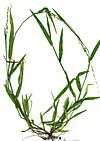Stipeae
Appearance
| Stipeae | |
|---|---|

| |
| Stipa gigantea | |
| Scientific classification | |
| Kingdom: | Plantae |
| Clade: | Tracheophytes |
| Clade: | Angiosperms |
| Clade: | Monocots |
| Clade: | Commelinids |
| Order: | Poales |
| Family: | Poaceae |
| Subfamily: | Pooideae |
| Supertribe: | Stipodae |
| Tribe: | Stipeae Dumort. (1824) |
| Genera | |
|
28 genera, see text | |
| Synonyms[1] | |
| |
The Stipeae are a tribe of grasses within the subfamily Pooidae, with up to 600 described species.[2]
Description
The defining morphological features of the Stipeae include single-flowered spikelets lacking a rachilla extension, and the lemmas (the external bract) have either a sharp point or a terminal awn (long bristle).[3]
Genera
The tribe includes 28 genera:[1]
- Achnatherum (syn. Aristella)
- Aciachne
- Amelichloa
- Anatherostipa (syn. Nicoraella)
- Anemanthele
- Austrostipa
- Celtica
- Eriocoma
- Hesperostipa
- Jarava
- Lorenzochloa
- Macrochloa
- Oloptum
- Ortachne
- Orthoraphium
- Oryzopsis
- Pappostipa
- Patis
- Nassella
- Piptatheropsis
- Piptatherum
- Piptochaetium
- Psammochloa
- Ptilagrostis
- Stipa
- Stipellula (syn. Stipella)
Many species initially placed into Stipa have now been split off into new genera. Some recent papers have analysed relationships within and between the genera,[4][5][6] but a complete analysis has not yet been performed. Stipoid grasses use the C3 photosynthetic pathway and live in temperate areas worldwide.[7]
Known fossils date from the late Miocene.[8]
References
- ^ a b Soreng, Robert J.; Peterson, Paul M.; Romaschenko, Konstantin; Davidse, Gerrit; Zuloaga, Fernando O.; Judziewicz, Emmet J.; Filgueiras, Tarciso S.; Davis, Jerrold I.; Morrone, Osvaldo (2015). "A worldwide phylogenetic classification of the Poaceae (Gramineae)". Journal of Systematics and Evolution. 53 (2): 117–137. doi:10.1111/jse.12150. ISSN 1674-4918.

- ^ Barkworth ME, Arriaga MO, Smith JF, Jacobs SWL, Valdes-Reyna J, Bushman BS (2008) Molecules and Morphology in South American Stipeae (Poaceae). Systematic Botany 33(4), 719-731.
- ^ Cialdella AM, Giussani LM, Aagesen L, Zuloaga FO, Morrone O (2007) A phylogeny of Piptochaetium (Poaceae : Pooideae : Stipeae) and related genera based on a combined analysis including trnL-F, rp116, and morphology. Systematic Botany 32(3), 545-559.
- ^ Barber JC, Hames KA, Cialdella AM, Giussani LM, Morrone O (2009) Phylogenetic relationships of Piptochaetium Presl (Poaceae: Stipeae) and related genera reconstructed from nuclear and chloroplast sequence datasets. Taxon 58(2), 375-380.
- ^ Jacobs SWL, Bayer R, Everett J, Arriaga MO, Barkworth ME, Sabin-Badereau A, Torres MA, Vazquez FM, Bagnall N (2007) Systematics of the tribe Stipeae (Gramineae) using molecular data. Aliso 23, 349-361.
- ^ Jacobs SWL, Everett J, Barkworth ME, Hsiao C (2000) Relationships within the Stipoid grasses (Gramineae). In 'Grass Systematics and Evolution.' (Eds SWL Jacobs and J Everett) pp. 75-82. (CSIRO: Melbourne)
- ^ Romaschenko K, Peterson PM, Soreng RJ, Garcia-Jacas N, Futorna O, Susanna A (2008) Molecular phylogenetic analysis of the American Stipeae (Poaceae) resolves Jarava sensu lato polyphyletic: evidence for a new genus, Pappostipa. Journal of the Botanical Research Institute of Texas 2(1), 165-192.
- ^ Thomasson JR (2005) Berriochloa gabeli and Berriochloa huletti (Gramineae: Stipeae), two new grass species from the late Miocene Ash Hollow Formation of Nebraska and Kansas. J Paleontol 79 (1):185-199
External links
Wikimedia Commons has media related to Stipeae.
Wikispecies has information related to Stipeae.

